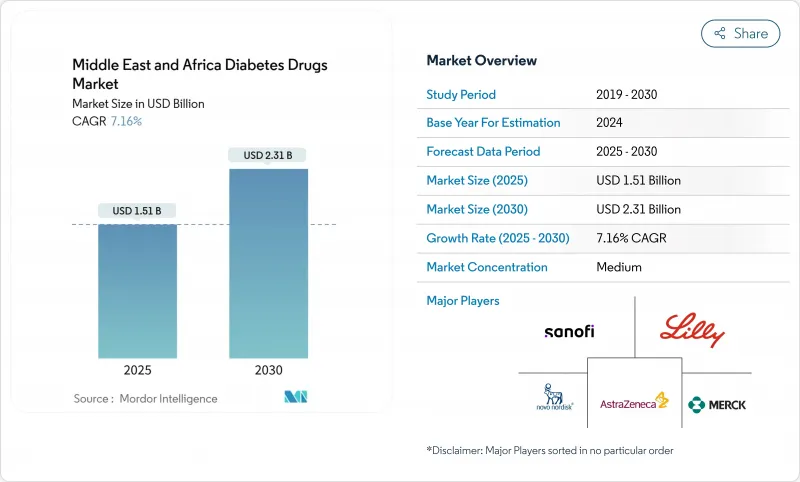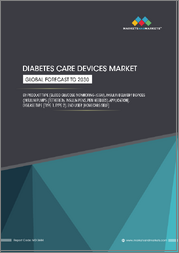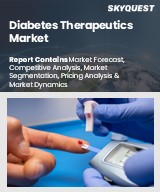
|
시장보고서
상품코드
1842435
중동 및 아프리카의 당뇨병 치료제 : 시장 점유율 분석, 산업 동향, 통계, 성장 동향 예측(2025-2030년)Middle East And Africa Diabetes Drugs - Market Share Analysis, Industry Trends & Statistics, Growth Forecasts (2025 - 2030) |
||||||
중동 및 아프리카의 당뇨병 치료제 시장 규모는 2025년에 15억 1,000만 달러가 되고, CAGR 7.16%를 나타내 2030년에는 23억 1,000만 달러에 달할 것으로 예상됩니다.

가속하는 2형 당뇨병 유병률, 비만률 상승, 젊은층과 도시 지역의 환자층 확대가 지속적인 수요를 창출하고 있습니다. 사우디아라비아와 이집트 정부의 국산화 지침과 UAE의 신속 승인 패스웨이는 인슐린과 신규 주사제의 국내 생산을 자극하고 있습니다. 경구 세마글루티드나 주 1회 투여의 티르제파티드 등 프리미엄 GLP-1 수용체 작용제는 보험 가입한 걸프 협력 회의(GCC) 사람들 사이에서 지지를 모으고 있는 반면 사하라 이남 아프리카에서는 가격에 민감한 층이 새로운 관민 파트너십을 통해 공급되는 인간 인슐린에 의존하고 있습니다. 한편, e Pharmacey 플랫폼은 환자의 의약품 입수 방법을 바꾸고 있으며, 지역 연구에서 얻은 실제 환경에 맞는 근거는 병용 요법의 조기 개시로 의사를 이끌고 있습니다.
중동 및 아프리카의 당뇨병 치료제 시장 동향 및 인사이트
당뇨병과 비만의 유병률 상승
새롭게 발표된 2024년 병원 등록 최신판에서는 GCC 국가 전체에서 2자리수의 당뇨병 유병률이 확인되었으며, 사우디아라비아의 클리닉에서는 내원 환자의 기준선 HbA1c치가 10%를 넘고 있는 것으로 보고되어 대사 악화의 심각성이 부각되었습니다. 도시로의 이주, 식생활의 구미화, 앉을 수 없는 노동 패턴이 계속해 체격 지수를 상승시켜, 평생의 치료 기간을 장기화시키고 있습니다. 건강 관리에 대한 접근이 중단된 아프리카의 주요 도시로 가공 식품이 침투함에 따라, 이 동향은 남쪽으로 퍼지고 있습니다. 제약회사에게는 기초인슐린제제, GLP-1작용약, 신흥의 주 1회 투여 알약의 대상인구가 확대하게 됩니다. 또한 예방적인 공중보건 지출도 강화되어 체중조절약의 처방을 지지하게 됩니다.
당뇨병 약에 대한 접근성 개선을 위한 정부의 이니셔티브
사우디아라비아의 National Unified Procurement Company(NUPCO)는 2024년 10월 다국적 제조업체와 10건의 각서를 체결하고 인슐린과 GLP-1 생산을 현지화함으로써 Vision 2030의 목표를 달성하면서 공급 안정성을 향상시켰습니다. 이집트에서는 2024년 12월에 엘리 릴리와 EVA 파마가 최초의 국산 인슐린 글라진을 출시해 2030년까지 100만명의 환자를 목표로 하고 있습니다. UAE에서는 2025년 연방법령 제38호에 따라 조건부 승인 패스웨이와 약물감시의 의무화가 정해져 혁신적인 분자 시장 투입까지의 시간이 단축됩니다.
신규 치료제의 고비용
중동 및 아프리카의 당뇨병 치료제 시장이 확대되어도 GCC의 부유층과 사하라 이남의 아프리카의 저소득층 사이에는 치료비 격차가 확산되고 있습니다. 2025년에 에티오피아의 1차 케어 클리닉에서 실시된 질적 평가는 가계 제약, 부족한 보험 옵션, 제한된 기구의 가용성이 특히 인슐린을 필요로 하는 환자에게 최적의 치료를 방해하는 것으로 나타났습니다. 2024년 6월에 완료된 나이지리아의 현지 조사는 응답자의 80% 이상이 선발 의약품의 가격을 엄청난 것으로 생각하고, 과거의 제네릭 의약품으로 흐르고 있는 것으로 나타났습니다. 따라서 제조업체는 가격 및 기부 프로그램을 만들어야 하지만 정부는 치료 불평등을 해소하기 위해 대량 조달 파트너십을 모색하고 있습니다.
보고서에서 분석된 기타 성장 촉진요인 및 억제요인
- GCC에 있어서의 의료보험의 적용 범위 확대
- e-Pharmacy 플랫폼의 급성장
- 비공식 채널의 위조 의약품
부문 분석
비인슐린 주사제는 연률 9.12%를 나타내 2024년 경구약이 차지했던 38.46%의 점유율에 달했습니다. 이 변화는 사우디아라비아의 임상의가 일상 진료로 경구 세마글루티드의 투여를 개시한 지 6개월 후 평균 HbA1c 저하율 3.1%, BMI 저하율 19.7%를 기록한 것으로 밝혀졌습니다. 중동 및 아프리카 비인슐린 주사제의 당뇨병 치료제 시장 규모는 기저 인슐린의 두 배 페이스로 상승할 것으로 예측됩니다. 2024년 아랍에미리트(UAE) 코호트에서 틸제파티드의 주 1회 투여는 피보탈 시험의 효능을 재현하고, 환자의 약 3분의 2가 40주 이내에 혈당 목표치를 달성하였습니다. 이러한 결과는 각 지역 포뮬러가 치료 알고리즘의 초기 단계에서 프리미엄 GLP-1/GIP 코어 고니스트를 나열하는 것을 뒷받침합니다.
노보놀디스크와 아스펜이 남아프리카에서 인슐린 카트리지의 현지 생산을 시작하고 인크레틴 모방약을 인근 시장에 수입하는 능력이 확보되었기 때문에 GLP-1 수요도 남부로 확산되고 있습니다. 메트포르민과 DPP-4 억제제를 결합한 합제 정제는 여러 병태를 가진 노인 환자의 요법을 단순화할 수 있으므로 단기적인 보급이 예상됩니다. 2025년 O-SEMA-FAST 조사와 같은 라마단 특유의 어드히어런스 조사는 금식 기간 동안 문화에 맞는 처방 패턴에 정보를 제공합니다. 전반적으로 바이오시밀러 GLP-1이 2020년대 후반에 특허가 끊어지기 때문에 경쟁이 치열해지고 있습니다.
기타 혜택 :
- 엑셀 형식 시장 예측(ME) 시트
- 3개월간의 애널리스트 서포트
목차
제1장 서론
- 조사 전제조건과 시장 정의
- 조사 범위
제2장 조사 방법
제3장 주요 요약
제4장 시장 상황
- 시장 개요
- 시장 성장 촉진요인
- 당뇨병과 비만의 유병률 상승
- 당뇨병 약에 대한 접근을 개선하기 위한 정부의 이니셔티브
- GCC에 있어서의 의료보험의 적용 확대
- 합제의 채용 확대
- 저비용의 제네릭/바이오시밀리아 당뇨병 치료제의 대두
- 전자 약국 플랫폼의 급성장
- 시장 성장 억제요인
- 신규 치료제의 고비용
- 사하라 이남의 아프리카에서의 콜드체인 격차
- 치료 강화에 대한 의사의 타성
- 비공식 채널에서 위조 의약품
- 가치/공급망 분석
- 규제 상황
- 기술 전망
- Porter's Five Forces 분석
- 공급기업의 협상력
- 구매자의 협상력
- 신규 참가업체의 위협
- 대체품의 위협
- 경쟁 기업 간 경쟁 관계의 강도
제5장 시장 규모 및 성장 예측(금액-달러)
- 치료 클래스별
- 경구용 항당뇨병제
- 인슐린
- 복합제
- 비인슐린 주사제
- 당뇨병 유형별
- 1형 당뇨병
- 2형 당뇨병
- 유통 채널별
- 병원 약국
- 소매 약국
- 온라인 약국
- 지역별
- 사우디아라비아
- 아랍에미리트(UAE)
- 오만
- 이란
- 이집트
- 남아프리카
- 기타 중동 및 아프리카
제6장 경쟁 구도
- 시장 집중도
- 시장 점유율 분석
- 기업 프로파일
- Novo Nordisk A/S
- Sanofi
- Eli Lilly and Company
- Merck & Co.
- AstraZeneca
- Boehringer Ingelheim
- Janssen Pharmaceuticals
- Pfizer
- Novartis
- Takeda
- Astellas Pharma
- GlaxoSmithKline
- Sun Pharma
- Cipla
- Hikma Pharmaceuticals
- Julphar
- Biocon
- Aspen Pharmacare
제7장 시장 기회와 전망
KTH 25.10.28The Middle East and Africa diabetes treatment market size stood at USD 1.51 billion in 2025 and is projected to reach USD 2.31 billion by 2030, reflecting a steady 7.16% CAGR.

Accelerating prevalence of type 2 diabetes, rising obesity rates, and the expanding pool of younger, urban patients are generating durable demand. Government localization mandates in Saudi Arabia and Egypt, coupled with the UAE's fast-track approval pathways, are stimulating domestic production of insulin and novel injectables. Premium GLP-1 receptor agonists such as oral semaglutide and once-weekly tirzepatide are gaining traction among insured Gulf Cooperation Council (GCC) populations, while price-sensitive segments in Sub-Saharan Africa continue to rely on human insulin supplied through new public-private partnerships. Meanwhile, e-pharmacy platforms are changing how patients obtain medications, and real-world evidence from regional studies is guiding physicians toward earlier initiation of combination therapy.
Middle East And Africa Diabetes Drugs Market Trends and Insights
Rising Prevalence of Diabetes & Obesity
Newly published 2024 hospital registry updates confirm double-digit diabetes prevalence across GCC states, with Saudi clinics reporting baseline HbA1c readings above 10% in incoming patients, underscoring the severity of metabolic deterioration. Urban migration, dietary westernization, and sedentary work patterns continue to raise body-mass indices, lengthening lifetime treatment duration. The trend is spreading southward as processed foods penetrate major African cities where healthcare access is fragmented. For pharmaceutical companies, this enlarges the addressable population for basal insulin, GLP-1 agonists, and emerging once-weekly pills. It also strengthens the case for preventive public-health spending, which in turn supports formularies covering weight-control agents.
Government Initiatives for Improving Diabetic Medication Access
Saudi Arabia's National Unified Procurement Company (NUPCO) signed ten memoranda of understanding with multinational manufacturers in October 2024 to localize insulin and GLP-1 production, improving supply security while meeting Vision 2030 objectives. Egypt followed suit in December 2024 when Eli Lilly and EVA Pharma launched the first domestically produced insulin glargine, targeting one million patients by 2030. In the UAE, the 2025 Federal Decree-Law No. 38 sets conditional approval pathways and mandatory pharmacovigilance, shortening the time to market for innovative molecules.Collectively, these policies reduce import dependence, enforce quality standards, and foster technology transfer, making locally sourced biologics more affordable.
High Cost of Novel Therapies
Even as the Middle East and Africa diabetes treatment market expands, affordability gaps widen between affluent GCC consumers and low-income groups in Sub-Saharan Africa. A 2025 qualitative assessment across Ethiopian primary-care clinics found that constrained household budgets, scarce insurance options, and limited device availability continue to hamper optimal care, especially for insulin-requiring patients. Nigerian field interviews completed in June 2024 revealed that more than 80% of respondents considered branded medication prices prohibitive, steering them toward older generics. Consequently, manufacturers must craft tiered-pricing and donation programs while governments seek bulk-procurement partnerships to bridge therapeutic inequality.
Other drivers and restraints analyzed in the detailed report include:
- Expanding Health Insurance Coverage in GCC
- Rapid Growth of e-Pharmacy Platforms
- Counterfeit Drugs in Informal Channels
For complete list of drivers and restraints, kindly check the Table Of Contents.
Segment Analysis
Non-insulin injectables are projected to grow at 9.12% annually, gradually eating into the 38.46% share that oral drugs held in 2024. The shift became evident when Saudi clinicians documented a 3.1% mean HbA1c decline and a 19.7% BMI reduction six months after initiating oral semaglutide in routine practice. The Middle East and Africa diabetes treatment market size for non-insulin injectables is expected to climb at double the pace of basal insulin because payers are linking reimbursement to weight management and cardiovascular outcomes. Weekly tirzepatide therapy replicated pivotal-trial efficacy in a 2024 UAE cohort, with nearly two-thirds of patients achieving glycemic targets inside 40 weeks. These results embolden regional formularies to list premium GLP-1/GIP co-agonists earlier in treatment algorithms.
GLP-1 demand is also spreading south as Novo Nordisk and Aspen begin local insulin cartridge production in South Africa, freeing capacity to import incretin mimetics into neighboring markets. Fixed-dose tablets that combine metformin with DPP-4 inhibitors are positioned for short-term uptake because they simplify regimens for multi-morbid elderly patients. Ramadan-specific adherence research, such as the 2025 O-SEMA-FAST study, is informing culturally tailored prescribing patterns during fasting periods. Overall, competition is intensifying as biosimilar GLP-1s approach patent expiry in the late 2020s, at which point low-cost regional manufacturers plan to launch.
The Middle East and Africa Diabetes Drugs Market Report is Segmented by Therapy Class (Oral Anti-Diabetic Drugs, Insulins, Non-Insulin Injectable Drugs, and More), Diabetes Type (Type 1 Diabetes and Type 2 Diabetes), Distribution Channel (Hospital Pharmacies, Retail Pharmacies and More) and Geography (Saudi Arabia, United Arab Emirates, Oman, Iran, Egypt, and More). The Market Forecasts are Provided in Terms of Value (USD).
List of Companies Covered in this Report:
- Novo Nordisk
- Sanofi
- Eli Lilly and Company
- Merck
- AstraZeneca
- Boehringer Ingelheim
- Janssen
- Pfizer
- Novartis
- Takeda Pharmaceuticals
- Astellas Pharma
- GlaxoSmithKline
- Sun Pharmaceuticals Industries
- Cipla
- Hikma Pharmaceuticals
- Julphar
- Biocon
- Aspen Pharmacare
Additional Benefits:
- The market estimate (ME) sheet in Excel format
- 3 months of analyst support
TABLE OF CONTENTS
1 Introduction
- 1.1 Study Assumptions and Market Definition
- 1.2 Scope of the Study
2 Research Methodology
3 Executive Summary
4 Market Landscape
- 4.1 Market Overview
- 4.2 Market Drivers
- 4.2.1 Rising prevalence of diabetes & obesity
- 4.2.2 Government Initiatives for improving diabetic medications access
- 4.2.3 Expanding health-insurance coverage in GCC
- 4.2.4 Growing adoption of fixed-dose combinations
- 4.2.5 Emegence of low-cost Generic/ Biosimiliar Diabetic Medciations
- 4.2.6 Rapid growth of e-pharmacy platforms
- 4.3 Market Restraints
- 4.3.1 High cost of novel therapies
- 4.3.2 Cold-chain gaps in Sub-Saharan Africa
- 4.3.3 Physician inertia to intensify therapy
- 4.3.4 Counterfeit drugs in informal channels
- 4.4 Value / Supply-Chain Analysis
- 4.5 Regulatory Landscape
- 4.6 Technology Outlook
- 4.7 Porter's Five Forces Analysis
- 4.7.1 Bargaining Power of Suppliers
- 4.7.2 Bargaining Power of Buyers
- 4.7.3 Threat of New Entrants
- 4.7.4 Threat of Substitutes
- 4.7.5 Intensity of Competitive Rivalry
5 Market Size and Growth Forecasts (Value-USD)
- 5.1 By Therapy Class
- 5.1.1 Oral Anti-diabetic Drugs
- 5.1.2 Insulins
- 5.1.3 Combination Drugs
- 5.1.4 Non-Insulin Injectable Drugs
- 5.2 By Diabetes Type
- 5.2.1 Type 1 Diabetes
- 5.2.2 Type 2 Diabetes
- 5.3 By Distribution Channel
- 5.3.1 Hospital Pharmacies
- 5.3.2 Retail Pharmacies
- 5.3.3 Online Pharmacies
- 5.4 By Geography
- 5.4.1 Saudi Arabia
- 5.4.2 United Arab Emirates
- 5.4.3 Oman
- 5.4.4 Iran
- 5.4.5 Egypt
- 5.4.6 South Africa
- 5.4.7 Rest of Middle East & Africa
6 Competitive Landscape
- 6.1 Market Concentration
- 6.2 Market Share Analysis
- 6.3 Company profiles (includes Global level Overview, Market level overview, Core Segments, Financials as available, Strategic Information, Market Rank/Share for key companies, Products and Services, and Recent Developments)
- 6.3.1 Novo Nordisk A/S
- 6.3.2 Sanofi
- 6.3.3 Eli Lilly and Company
- 6.3.4 Merck & Co.
- 6.3.5 AstraZeneca
- 6.3.6 Boehringer Ingelheim
- 6.3.7 Janssen Pharmaceuticals
- 6.3.8 Pfizer
- 6.3.9 Novartis
- 6.3.10 Takeda
- 6.3.11 Astellas Pharma
- 6.3.12 GlaxoSmithKline
- 6.3.13 Sun Pharma
- 6.3.14 Cipla
- 6.3.15 Hikma Pharmaceuticals
- 6.3.16 Julphar
- 6.3.17 Biocon
- 6.3.18 Aspen Pharmacare
7 Market Opportunities and Future Outlook
- 7.1 White-Space and Unmet-Need Assessment

















